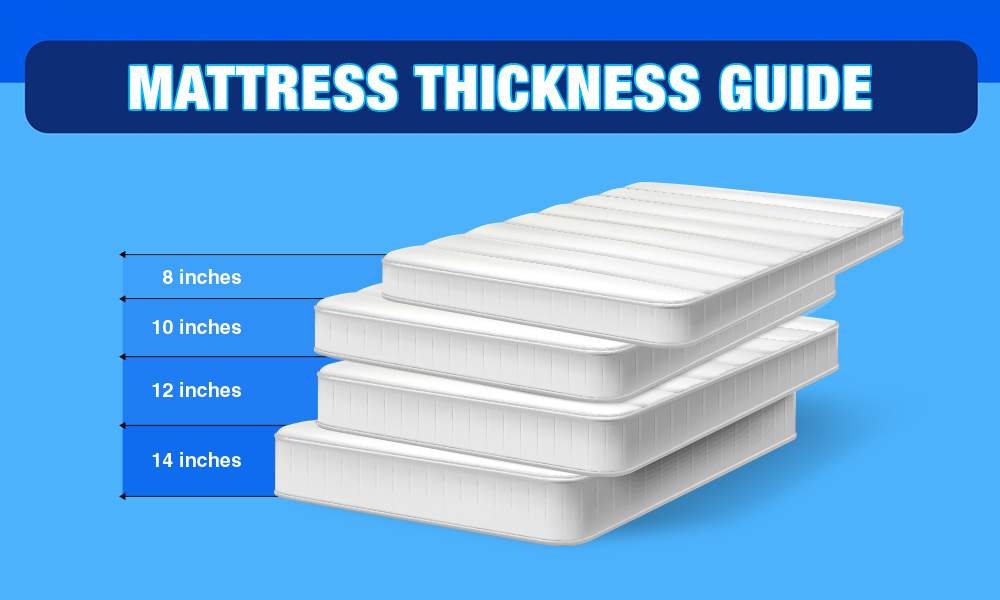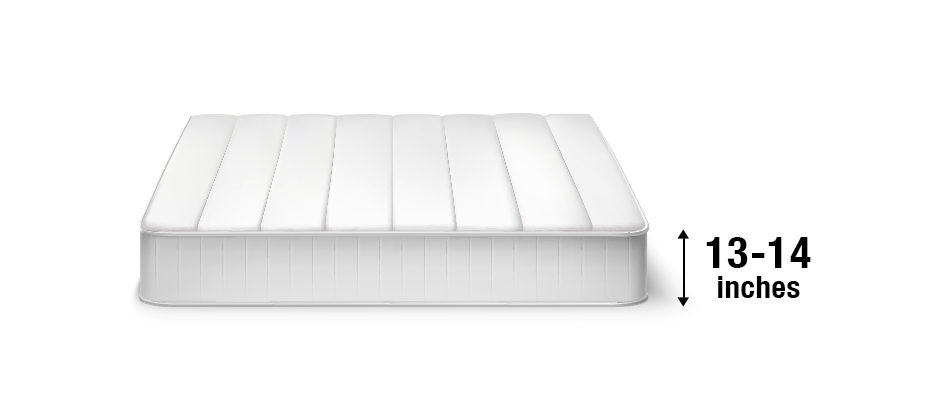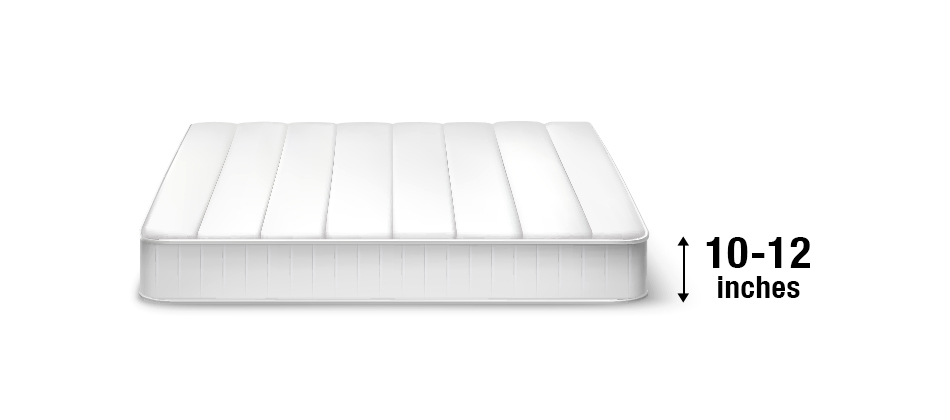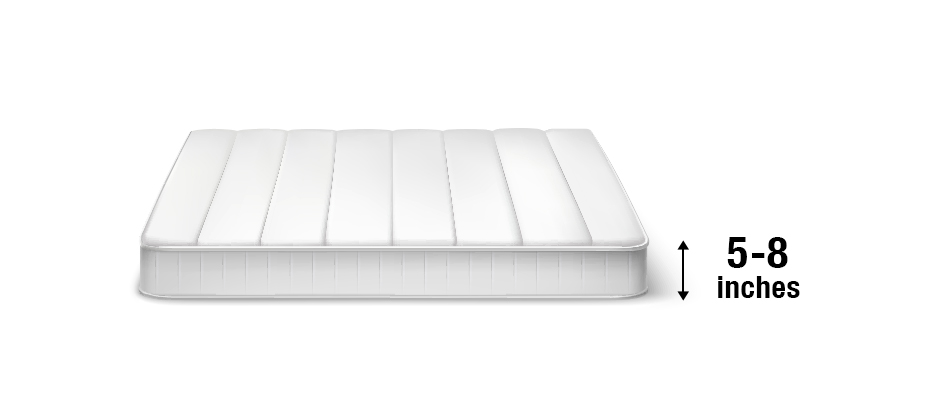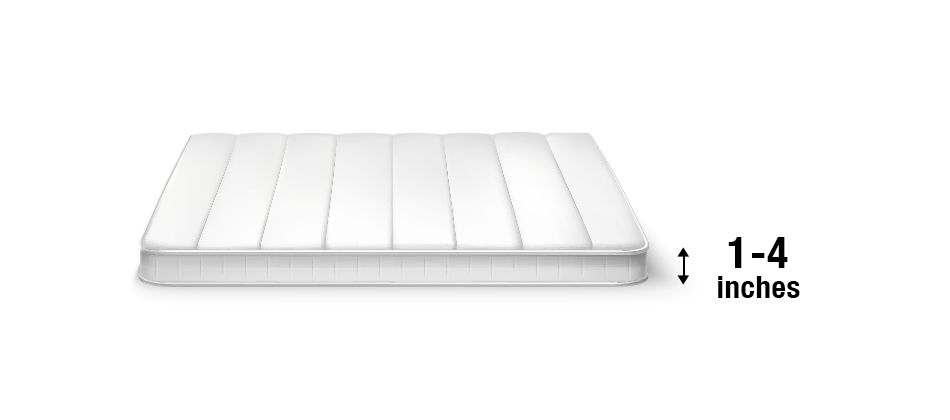Mattress Thickness
How to choose the right mattress thickness?
Mattress thickness can play a role in choosing the right mattress. A standard mattress thickness ranges from 10 to 12 inches. A mattress thickness that ranges from 17 to 20 inches is extremely thick. The importance of the mattress thickness is usually based on a person’s height. Taller people tend to need thicker mattresses. For them, 14 to 20 inches are more appropriate since it will be easier to get in and out of bed. A person of average height can do well with 10 to 12 inches. Thus, the most important thing to keep in mind when choosing the right thickness is your height.
Mattress Thickness Chart
| Mattress Thickness | Dimensions (IN) | Dimensions (CM) |
|---|---|---|
|
Very Thick Mattress
|
15 inches to 20 inches
|
38.10 cm by 50.8 cm
|
|
Thick Mattress
|
13 inches to 14 inches
|
33.02 cm by 35.56 cm
|
|
Standard Mattress
|
10 inches to 12 inches
|
25.40 cm by 30.48 cm
|
|
Low Profile Mattress
|
5 inches to 8 inches
|
12.70 cm by 20.32 cm
|
|
Mattress Topper
|
1 inches to 4 inches
|
2.54 cm by 10.16 cm
|
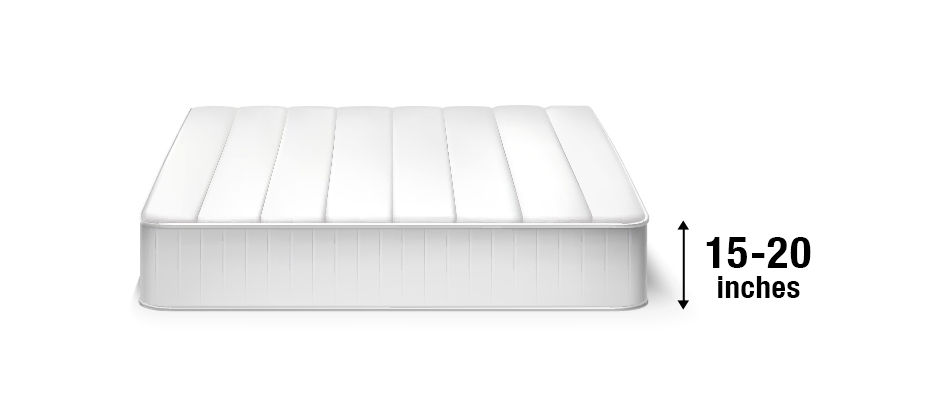
Mattress that are 15 to 20 inches thick harder to come by, but they are available. A 16 inch mattress is the easiest thickness to find in this range. Many 20-inch mattresses are going be more custom made because few need or want a mattress that thick. The range from 17 to 20 inches is the least popular. The average height for a male in the US is 5’9″, while for a female is 5’4″. People with these heights will find these very thick mattresses to be too high. A simple way for you to know if a mattress is too thick if you sit on it and your feet do not reach the floor. It may seem superficial when you read about it. But, when you experience it every day, then you will realize the struggle. You will find out how inconvenient and maybe even annoying getting in and out of bed will be. You will realize this if you are the type who sits at the edge of their bed when putting on footwear. You will find that it is practically impossible if your mattress is too thick. These nuances matter for the elderly and people with special health conditions.
Thick Mattresses (13 to 14 inches)
Mattresses that are 13 to 14 inches thick is still a little above the standard. These mattresses can come in different comfort levels such as soft, medium, or firm. Oftentimes these mattresses are hybrids. Hybrid mattresses combine an innerspring system with layers of memory foam or latex. A memory foam mattress is great for pressure relief. Meanwhile, and innerspring mattress offers stable support. Thus, a hybrid mattress offers a balance of both. Many of these mattresses also come as a pillow-top. This extra feature offers more plushness. It also lowers the bounce and firmness from the innerspring system underneath. Mattresses that are 13 to 14 inches thick tend to be for people that want a little taller mattress. They can also be for people that want a traditional pillow-top mattress.
Standard Mattress Thickness (10 to 12 inches)
The standard mattress thickness ranges from 10 to 12 inches. Mattresses that are 10 inches thick tend to be firmer, but there are still some soft ones. Mattress that are 12 inches thick are the ones that are commonly soft or medium. The reason why many 12-inch mattress are medium or soft is there is a thicker comforter layer. Many 12 inch memory foam mattresses often have a layers of cooling gel and transfer foam.
Low profile mattress (5 to 8 inches)
Mattress that are between 5 to 8 inches thick are more common in recreational vehicles (RVs) and hospital beds. RVs need low mattresses because RVs have limited spaces. These mattresses are also common in hospitals. Hospitals need low mattress because they make it easier for patients to get in and out of bed. These low mattresses also allow nurses, doctors, and caregivers assist the patients. For example, they may need to transfer the patients from the bed to a wheelchair or sling. An 8 inch memory foam mattress can come as soft, medium, or firm. There are also hospital bed mattresses that can come with coils, memory foam, hybrid layers, or air.
Mattress Toppers (1 to 4 inches)
A mattress topper is another layer that you place on top of your mattress. It provides more cushioning and support. A mattress topper can be 1 to 4 inches thick. The most common sizes of mattress toppers are 1 to 2 inches. Usually, the thicker the mattress topper, the softer it is, but not always. It depends on the material the mattress topper is made of. A latex firm topper that is 4 inches thick can be firmer than a memory foam mattress topper that is also 4 inches thick. Thus, it is important to know both the material and the thickness of the mattress topper.
Other Things to Consider When Choosing Mattress Thickness
Bed Height
Remember that the height of your bed is your mattress thickness plus your bed frame height. If your bed frame is. For a person of average height, a total bed height around 25 inches is comfortable. Thus, if your bed frame is already 12 inches high, then you may want a mattress that is 10 to 15 inches thick.
Sleeping Position
• Side sleepers may benefit more with mattresses that are 10 to 14 inches thick. Sleeping on your side puts weight on your shoulders and hips. If you sleep on your side on the wrong mattress, your shoulder and hip joints can suffer over time. You know that 10- to 14-inch mattresses are usually hybrids, latex, or memory foam. Thus, they offer enough cushion to relieve the pressure from your joints. Plus, they offer enough support to keep your spine stable.
• Back Sleepers may benefit more with mattress that are 10 inches thick. These mattresses tend to be medium (although there are still some soft ones). Thus, they offer enough support to keep your spine in a neutral position.
• Stomach sleepers can also enjoy the firmness of 10-inch mattresses. When you sleep on your stomach, your lower abdominal and pelvic areas will tend to sink down. A soft mattress will promote these areas to sink down. This effect will overextend your lower back and strain it. Stomach sleepers tend to prefer a firmer mattress.
Health Conditions
• Sciatica
People with sciatica have bone abnormalities in their spine. These abnormalities can irritate the sciatic nerve and cause excruciating pain. Lying down on the wrong surface can promote the irritation. Thus, a firm 10-inch or 12 inch medium mattress may be more beneficial. The firmness can keep the spine aligned and prevent sciatic pain.
• Joint or Bone Conditions
Joint conditions like arthritis can be excruciating as well. There are many types of arthritis. Whichever the case may be, people who suffer from them need proper cushioning to relieve them of the pain. In contrast, bone conditions like osteoporosis are not painful per se, but the effects are. The bones themselves can become so fragile that they are more prone to fractures. Thus, people with osteoporosis also need proper cushioning to keep their bones safe. For these people, a plush and soft 12-inch with a good support mattress may be suitable. They can also enjoy mattress toppers that offer more cushioning.
Conclusion
Sleep is an important part of life. Thus, when you are buying a mattress, you need to take it seriously. Mattress thickness is an aspect that you should not look over if you want to have regular restful sleep. You can find getting in and out of a bed that is too thick mildly annoying. Imagine how challenging it can be for the elderly. The same is true for someone with a broken leg or other health conditions. Plus, some companies give certain mattress thicknesses certain materials. Some traits like softness, firmness, and plushness are typical of certain mattress thicknesses. Plus, mattresses that have the same material and have the same thickness can still differ. For example, how Company A makes their memory foam can be different from how Company B makes theirs. Both can be memory foam, but one company can make theirs softer. The best way to know is to call the retailer, so they can point you in the right direction. Keep this mattress thickness guide in mind when shopping for a new mattress
